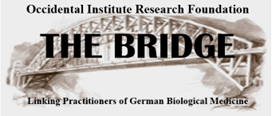First Matrix Research Prize Awarded To
Prof. Dr. rer. nat. med. habil. Hartmut Heine
Prize presented within the framework of the
Medicine Week Congress in Baden-Baden
The Saint Johanser company provided a matrix research prize, endowed it with €10,000 and awarded it to the anatomist and biologist Professor Dr. Hartmut Heine (formerly the director of the Anatomical and Clinical-Morphological Institutes of the University of Witten/Herdecke). A more than thirty year research project was acknowledged with that award, a project which has enabled a bridging between school medicine and complementary medicine and allowed a better understanding in general of life’s processes. Cellular events are steered by genes and proteins as the information storage medium; by contrast the extracellular, as Prof. Heine showed, by highly integrated sugars. They structure together the molecular sieve of the extracellular matrix (basic substance) with collagen and elastin. It is spread out between every cell and it supplies the finest blood vessels (endothelium).
Sugars can likewise store information through alterations of their structure, length and connection and can transmit to cellular receptors and chemical messengers.
Therefore they are more than just energy storage or construction and supporting elements.
Because of their incredibly variable combination possibilities, that by far surpass those of the genes and proteins, sugar represents a third alphabet of life.
While the inherited “long-term memory” is localized in the genes, the “short-term memory” is situated in the matrix. A regulated metabolism is only possible by constant feedback of both “memories” by means of proteins as chemical messengers.
These connections are put into their individual order through the regulation of the matrix (basic regulation), investigated thoroughly by Prof. Heine. To be exact, the final distribution spreads out in the matrix not the Will subjected to sensitive motoric and vegetative nerve fibers, whereby the functional status of the matrix is registered directly in the brain. Beyond the blood capillaries the matrix is also connected to the hormone system and beyond the patrolling defensive cells to the immune system.
Nervous, hormone and immune systems are interconnected in the brain and the periphery in many varied ways, whereby the matrix represents the regulated and regulating interface. Since all information entering from the internal and external environment gathers in the matrix, according to Prof. Heine it is also the place of common functions of the soma and the psyche. From the view of matrix research every physical illness therefore always also has a psychological component and the reverse (e.g. rheumatic illnesses).
According to the investigations of Prof. Heine continuing inadequate information input over a longer time leads, after a non-standard shorter or longer adaptation phase, to adjusted matrix rebuilding with corresponding misinformation for the downstream cells. Since the cell receptors contain not only sugar components, they also stand in direct connection with the matrix. After the first reversible adaptation phase with a prolonged burden, it finally becomes dependent on the individual conditions and the constitution to illnesses, particularly for chronic ones as well as tumors.
The knowledge of the dependence of basic regulation on external and internal influences could be of use not only for the scientific explanation of individual oriented complementary medicine, but also includes with it objectified school medicine.
In 1987 the matrix company was founded on the incentive of Prof. Heine who was its first chairperson until 1999.
International acceptance of the research of Prof. Heine has also led to the development of special matrix therapies and the preparations suitable for it. Thus a new development is recognizable: Multi-Target-Therapy, i.e. the simultaneous attack by “leading” content materials of a preparation at regulation nodal points. This therapy form was investigated by Prof. Heine as Matricell®. The preparation is composed of Royal Jelly, propolis and dissolved pollen. It contains three actuators for protection from tissue over-acidification: Niacin as a redox catalyst, ferulic acid as a pre- and probiotic and quercetin as a radical catcher [antioxidant]. All other ingredients support these functions, e.g. the health supporting polyphenol oxidase [laccase] of secondary plant materials together with the antimicrobial agents in propolis. However, the latent tissue acidosis that occurs in more than 50% of our population is a cause of persistent health disorders which for their part can be precursors of chronic diseases as well as tumors.
In future the new matrix research prize is to be awarded to researchers of all therapeutic schools of thought whose work gives crucial impulse to the knowledge about the construction and function of the matrix.
 An exclusive article for Members
An exclusive article for Members
From THE BRIDGE Newsletter of OIRF
Published April 15, 2006
From an article in Naturheilpraxis mit Naturmedizin
Volume #58, Number 12, December 2005
Machine Translation by SYSTRAN, Lernout & Hauspie, LogoMedia & Promt
Translation & redaction by: Carolyn L. Winsor, OIRF
© Copyright 2006, München, Germany


